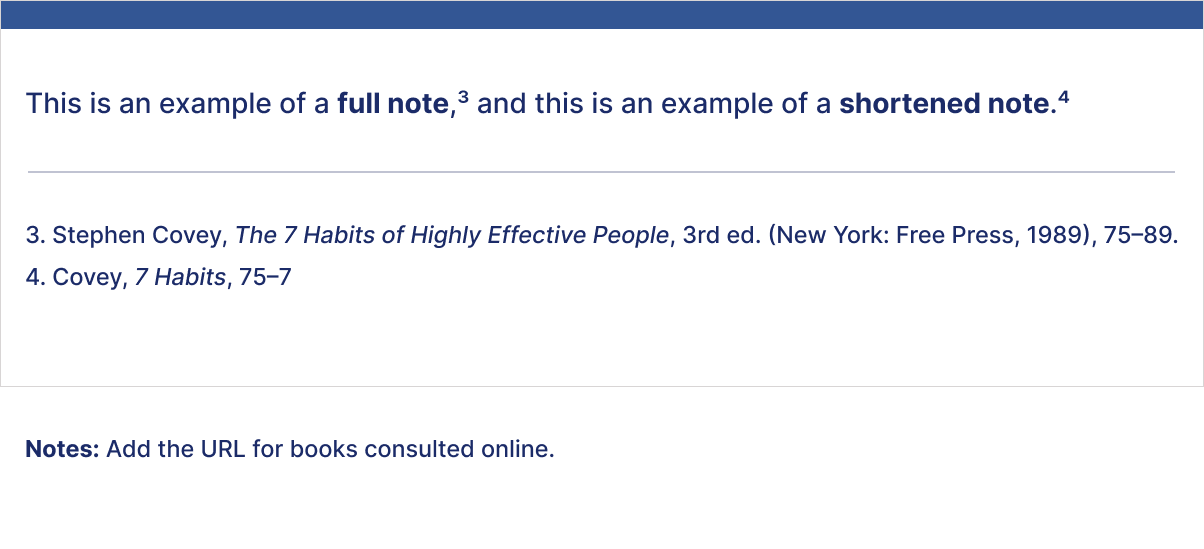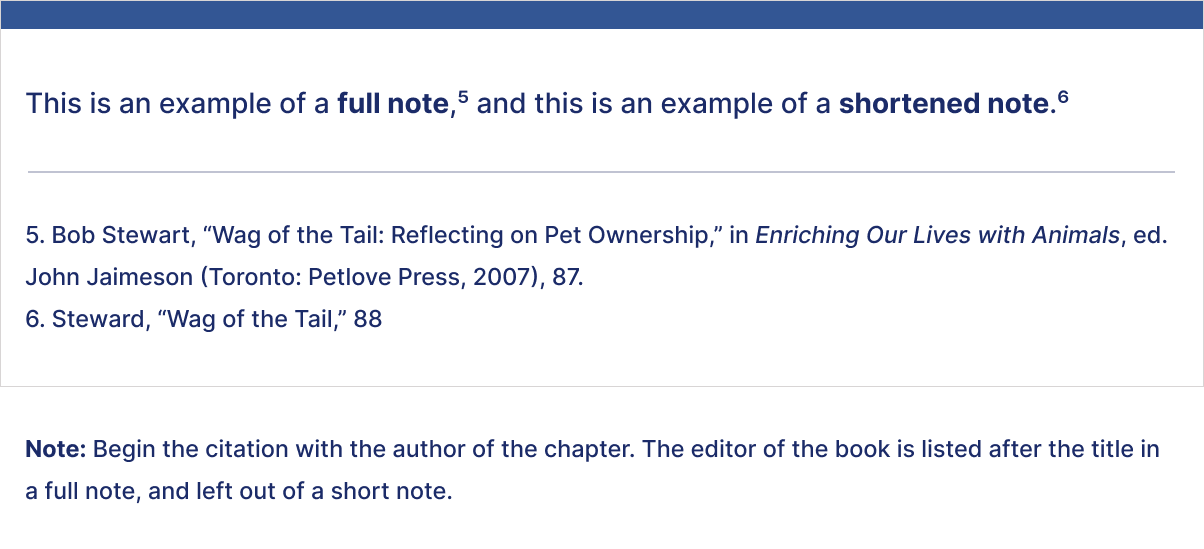Chicago In-text Citations | Styles, Format & Examples
An in-text citation is used to point readers toward any source you quote, paraphrase or refer to in your writing. The Chicago Manual of Style has two options for in-text citations:
- Author-date: you put your citations in parentheses within the text itself.
- Notes and bibliography: you put your citations in numbered footnotes or endnotes.
You should choose one of these two citation options and use it consistently throughout your text. The source details are listed in full in a bibliography or reference list at the end. Make sure to pay attention to punctuation (e.g., commas and quotation marks).
Author-date citation example
(Woolf 1921, 11)
Footnote citation example
1. Woolf, “Modern Fiction,” 11.
Which Chicago style should you use?
First, you need to decide whether you are using notes or author-date in-text citations. You can usually find out from your instructor or syllabus which style you should use.
The notes and bibliography system is usually preferred in humanities subjects like literature, history and the arts. The author-date system is preferred in the sciences, including social sciences.
The styles are similar in the information they present, but they differ in terms of the order, location, and format of that information. It’s important to use one style consistently, and not to confuse the two.
Option 1: Author-date in-text citations
Author-date style places citations directly in the text in parentheses. In-text citations include the author’s last name, the year of publication, and if applicable, a page number or page range:
This style of Chicago in-text citation looks the same for every type of source.
When using author-date, you should always include a reference list with an entry corresponding to each citation. This provides the reader with full publication information to locate the source.
Where should citations appear in the text?
The author-date style gives you some flexibility in where you place your citations in the text.
Most commonly, you will put the citation at the end of the relevant sentence (before the period). You can also integrate it into the sentence. If you name the author in your sentence, you only need to include the date and page number in parentheses.
Multiple citations can also be combined within one set of parentheses using a semicolon.
As you can see in the Valentine citation, it’s not always necessary to include a page number—only when you’re referring to a specific part of the text. If you want to cite the text as a whole, you can leave out the page number.
Option 2: Citations in footnotes or endnotes
In notes and bibliography style, your citations appear in either footnotes or endnotes.
To create a Chicago footnote or endnote reference, a superscript number is placed at the end of the clause or sentence that the citation applies to, after any punctuation (periods, quotation marks, parentheses). Your first citation is marked with a 1, your second with a 2, and so on.
These superscript numbers correspond to numbered footnotes or endnotes containing the actual citation.
Full notes and short notes
There are two types of note you can use in Chicago style: full and short.
- Full notes contain the full publication details of the source.
- Short notes contain the author’s last name, the title (shortened if it is longer than four words), and the page number (if relevant).
You should usually use a full note the first time you cite each source. If you cite the same source more than once, use a short note for each subsequent citation. You may also use “ibid.” to repeat the citation from the previous note, but short notes are the more usual choice.
The rules of your specific institution may vary, requiring you to use one of the two note styles every time. It’s important to check with your instructor if you’re unsure.
This is what a full and short note for the same citation might look like:
2. Woolf, “Modern Fiction”, 11.
The format of the note varies depending on the type of source. Below you can see examples of a Chicago website citation, book citation, book chapter citation, and journal article citation.
Chicago footnote citation examples
Footnotes or endnotes?
Footnotes appear at the bottom of the page they refer to, while endnotes appear in their own section at the end of the text, before the Chicago style bibliography.
The citation looks exactly the same whether it appears in a footnote or an endnote. If you haven’t been told which one to use, the choice is a matter of personal preference. The important thing is to consistently use one or the other.
Citing sources with multiple authors
In both styles, when you cite a source with two or three authors, list the names in the order they appear in the original publication:
When a source has four or more authors, use the term “et al.” after the first author’s name:
Here's why students love Scribbr's proofreading services
Missing information in Chicago in-text citations
Sometimes, not all of the information you need for your citation will be available. Thankfully, there are ways to work around this in both styles.
No page number
Page numbers are not always necessary; if the source doesn’t have page numbers (e.g., a website), or if you’re referring to the general argument of a text instead of a specific passage, you can omit page numbers.
If a source has no page numbers but you still want to specify a particular part of the text, you can use other locators like paragraphs, chapters or headings instead—whatever markers the text provides:
No publication date
If the source doesn’t have a stated publication date, you can write “n.d.” in place of the year:
No author
If no specific author is listed, you can refer to the organization that published the source:
Frequently asked questions about Chicago in-text citations
- When should I include page numbers in Chicago style citations?
-
Page numbers should be included in your Chicago in-text citations when:
- You’re quoting from the text.
- You’re paraphrasing a particular passage.
- You’re referring to information from a specific section.
When you’re referring to the overall argument or general content of a source, it’s unnecessary to include page numbers.
- When should I use “et al.” in Chicago style citations?
-
When a source has four or more authors, your in-text citation or Chicago footnote should give only the first author’s name followed by “et al.” (Latin for “and others”). This makes your citations more concise.
In your bibliography or reference list, when a source has more than 10 authors, list the first seven followed by “et al.” Otherwise, list every author.
- What is the difference between a Chicago reference list and a bibliography?
-
- A reference list is used with Chicago author-date citations.
- A bibliography is used with Chicago footnote citations.
Both present the exact same information; the only difference is the placement of the year in source citations:
- In a reference list entry, the publication year appears directly after the author’s name.
- In a bibliography entry, the year appears near the end of the entry (the exact placement depends on the source type).
There are also other types of bibliography that work as stand-alone texts, such as a Chicago annotated bibliography.
- Do I have to include a bibliography or reference list?
-
In Chicago author-date style, your text must include a reference list. It appears at the end of your paper and gives full details of every source you cited.
In notes and bibliography style, you use Chicago style footnotes to cite sources; a bibliography is optional but recommended. If you don’t include one, be sure to use a full note for the first citation of each source.
- Should I use short notes or full notes for my Chicago citations?
-
In Chicago notes and bibliography style, the usual standard is to use a full note for the first citation of each source, and short notes for any subsequent citations of the same source.
However, your institution’s guidelines may differ from the standard rule. In some fields, you’re required to use a full note every time, whereas in some other fields you can use short notes every time, as long as all sources are listed in your bibliography. If you’re not sure, check with your instructor.
Cite this Scribbr article
If you want to cite this source, you can copy and paste the citation or click the “Cite this Scribbr article” button to automatically add the citation to our free Citation Generator.
Caulfield, J. (2022, December 05). Chicago In-text Citations | Styles, Format & Examples. Scribbr. Retrieved January 8, 2024, from https://www.scribbr.com/chicago-style/chicago-in-text-citation/






